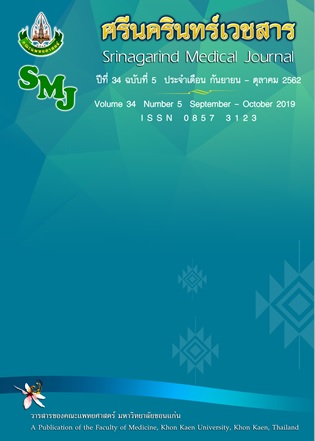Predictive Equations for Peak Cough Flow in Healthy Senior Persons
Keywords:
Cough; peak cough flow; senior adultsAbstract
Objective and objectives: Measurement of peak cough flow (PCF) is a simple, convenient and noninvasive method providing the indices of cough efficiency. However, physical factors that affecting PCF are not clearly determined. Therefore, the aim of this study was to analyze the factors contributing to PCF for establishing a set of regression equations for community-dwelling senior adults.
Method: One hundred and thirty healthy participants including 65 men and 65 women were recruited in this study. The PCF was performed by a quick, short, and most vigorous possible cough after a maximal inspiration on the peak flow meter. The highest values of those three measurements were recorded, individually.
Results: The PCF values were lower in women than in men. Moreover, the PCF was correlated with age, height, waist circumference, and weight in both genders. The predictive equations in men and women were as follow: PCF (all subjects) = 364.996 + [91.577 Gender] – 3.772 Age (year)] + [3.190 Weight (kg)],
PCFmen = 440.178 - 4.060 x (age) + 3.830 x (weight) (R2=0.357, P=0.005) and PCFwomen = 398.268 - 3.428 x (age) + 2.127 x (weight) (R2=0.231, P=0.006).
Conclusion: Age and weight factors are considered as covariates for PCF measurement. Furthermore, these equations could be used to calculate the predictive values of PCF for the healthy senior persons in clinical practice.
References
2. Suarez AA, Pessolano FA, Monteiro SG, Ferreyra G, Capria ME, Mesa L, et al. Peak flow and peak cough flow in the evaluation of expiratory muscle weakness and bulbar impairment in patients with neuromuscular disease. Am J Phys Med Rehabil 2002; 81: 506-11.
3. Morice AH, McGarvey L, Pavord I. Recommendations for the management of cough in adults. Thorax 2006; 61 (Suppl 1): i1-24.
4. Chang AB. The physiology of cough. Paediatr Respir Rev 2006; 7: 2-8.
5. Lee SC, Kang SW, Kim MT, Kim YK, Chang WH, Im SH. Correlation between voluntary cough and laryngeal cough reflex flows in patients with traumatic brain injury. Arch Phys Med Rehabil 2013; 94: 1580-3.
6. Tzeng AC, Bach JR. Prevention of pulmonary morbidity for patients with neuromuscular disease. Chest 2000; 118: 1390-6.
7. Tzani P, Chiesa S, Aiello M, Scarascia A, Catellani C, Elia D, et al. The value of cough peak flow in the assessment of cough efficacy in neuromuscular patients. A cross sectional study. Eur J Phys Rehabil Med 2014; 50: 427-32.
8. Cardoso FE, de Abreu LC, Raimundo RD, Faustino NA, Araujo SF, Valenti VE, et al. Evaluation of peak cough flow in Brazilian healthy adults. Int Arch Med 2012; 5: 25.
9. Yawata A, Tsubaki A, Yawata H, Takai H, Matsumoto K, Takehara N, et al. Voluntary cough intensity and its influencing factors differ by sex in community-dwelling adults. Ther Adv Respir Dis 2017; 11: 427-33.
10. Freitas FS, Ibiapina CC, Alvim CG, Britto RR, Parreira VF. Relationship between cough strength and functional level in elderly. Rev Bras Fisioter 2010; 14: 470-6.
11. Bianchi C, Baiardi P. Cough peak flows: standard values for children and adolescents. Am J Phys Med Rehabil 2008; 87: 461-7.
12. Adeniyi B, Erhabor G. The peak flow meter and its use in clinical practice. Afr J Respir Med 2011; 6: 5-7.
13. Souza CPVd, Ribeiro RKC, Lima LdV, Sant’Anna CC, Araújo APdQC. Peak cough flow in children and young people with spinal muscular atrophy types II and III. Fisioterapia Pesquisa 2018; 25: 432-7.
14. Gunnell D, Whitley E, Upton MN, McConnachie A, Davey Smith G, Watt GCM. Associations of height, leg length, and lung function with cardiovascular risk factors in the Midspan Family Study. J Epidemiol Community Health 2003; 57: 141-6.
15. Heinzmann-Filho JP, Vasconcellos Vidal PC, Jones MH, Donadio MV. Normal values for respiratory muscle strength in healthy preschoolers and school children. Respir Med 2012;106: 1639-46.
16. Ostrowski S, Barud W. Factors influencing lung function: are the predicted values for spirometry reliable enough? J Physiol Pharmacol 2006; 57 (Suppl 4): 263-71.
17. Bhatti U, Rani K, Memon MQ. Variation in lung volumes and capacities among young males in relation to height. J Ayub Med Coll Abbottabad 2014; 26: 200-2.
18. Sancho-Chust JN, Chiner E, Camarasa A, Senent C. Differences in pulmonary function based on height prediction obtained by using alternative measures. Respiration 2010; 79: 461-8.
19. Janssen I, Heymsfield SB, Wang Z, Ross R. Skeletal muscle mass and distribution in 468 men and women aged 18–88 yr. J Appl Physiol 2000; 89: 81-8.
20. Pessoa IMBS, Houri Neto M, Montemezzo D, Silva LAM, Andrade ADD, Parreira VF. Predictive equations for respiratory muscle strength according to international and Brazilian guidelines. Braz J Phys Ther 2014; 18: 410-8.
21. Park JH, Kang SW, Lee SC, Choi WA, Kim DH. How respiratory muscle strength correlates with cough capacity in patients with respiratory muscle weakness. Yonsei Med J 2010; 51: 392-7.
22. Kim J, Davenport P, Sapienza C. Effect of expiratory muscle strength training on elderly cough function. Arch Gerontol Geriatr 2009; 48: 361-6.
23. Harik-Khan RI, Wise RA, Fozard JL. Determinants of maximal inspiratory pressure. The Baltimore Longitudinal Study of Aging. Am J Respir Crit Care Med 1998; 158(5 Pt 1): 1459-64.
24. Jalayondeja W, Verner O, Jarungjitaree S, Tscheikuna J. Respiratory muscle strength explained by age and weight in female and male. J Med Assoc Thai 2014; 97 (Suppl 7): S16-20.




